When retaining talent, happier employees tend to stay in their jobs longer. Without the right talent, your company can’t grow its strategy. Your company can’t attract the talent it needs without the right people. It also risks its competitive edge. High employee retention adds value to the company’s bottom line and culture.
If you’ve faced retention challenges, it might be time to implement digital workplace changes. Employee retention strategies aim to increase worker satisfaction and minimize turnover. It can also reduce costs related to hiring, training, and developing new workers.
Developing retention strategies can encourage employees to stay with the organization.
This article will describe employee retention strategies and why they are important. Then, it will detail 17 of the best employee retention strategies and explain why employees stay and leave.
What are employee retention strategies?
Employee retention strategies are vital for reducing turnover rates. They form a key part of a business plan. An employee retention program typically involves company initiatives to attract and retain talented employees.
While some turnover is inevitable, acceptable rates vary across businesses and industries. Effective retention strategies can improve retention rates and reduce hiring and training costs. HR is crucial in devising and implementing policies that foster employee retention.
Why are employee retention strategies important?
Hiring top talent to achieve organizational goals is crucial. Losing an employee can be costly, so it’s vital to invest in employment retention strategies to retain your best performers and reduce turnover.
For instance, replacing an employee can be costly when you factor in recruitment, hiring, and training expenses.
Then, when an employee leaves, it often creates an open vacancy for several months. The remaining team members typically have to take on the extra workload. This leads to increased stress and pressure, negatively impacting performance and morale. It can also result in more resignations.
The longer employees stay with an organization, the more institutional knowledge they accumulate. They can also transfer this valuable knowledge to new hires, aiding in smoother transitions.
Employee retention strategies are also important as they allow employees to grow. This often leads to increased competencies, giving the company a competitive edge.
High employee retention rates mean relying less on hiring new employees to fill vacancies. This approach can result in more sustainable business growth in the long run.
The longer employees are with an organization, the more familiar they become with its processes and their colleagues’ working styles. This familiarity improves collaboration and helps everyone work towards shared goals.
17 of the most effective employee retention strategies
Here are 17 effective strategies for developing employee retention:
Streamlined onboarding
New hires generally always want to integrate well into the organization. They aim to perform and impress in their new roles. However, a poor employee onboarding process, or lack thereof, can prevent them from knowing what they need to succeed. This can leave them feeling unhappy at work.
The onboarding process starts as soon as a candidate signs their offer letter. It continues until they can perform the role they were hired for. It’s crucial to consider all key stages of the onboarding process. This includes preboarding, the first day, the first week, the first 90 days, and the end of the first year.
Help new employees by educating them on their responsibilities. Provide them with the resources and autonomy needed to complete their work. Foster an environment where they feel accepted. Introduce new hires to their teammates and pair them with a mentor to answer any questions. Ensure that you include remote employees in the onboarding process.
Additionally, find ways to integrate groups returning to work. This includes new parents and individuals returning from extended leave. It can also include contract workers transitioning to full-time positions.
Provide employees with the right tools
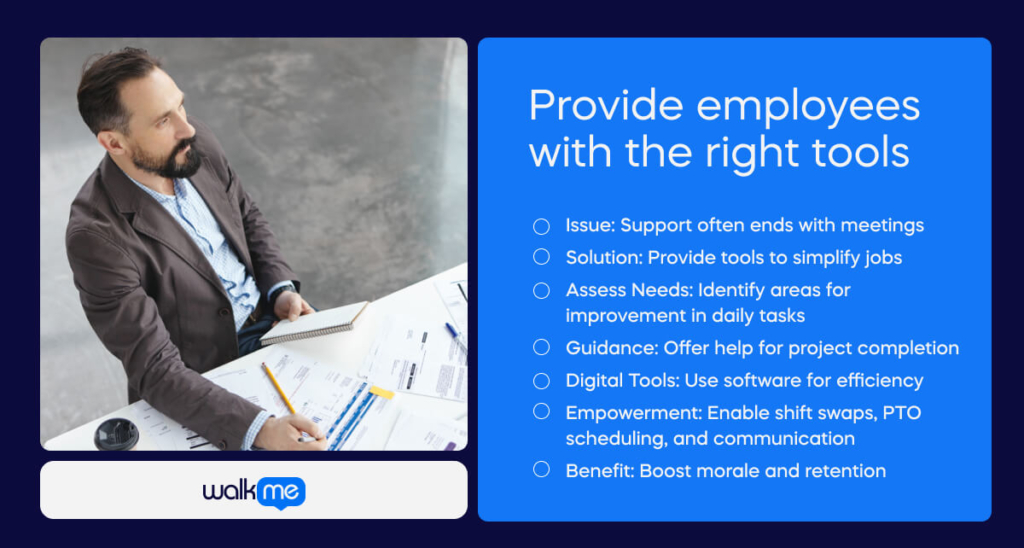
All too often, organizations fall short when supporting their employees.
For some, employee support begins and ends with regular meetings. While consistent one-on-ones are beneficial, they shouldn’t be the sole form of support. To empower your employees, offer them tools that simplify their job.
Examine your staff’s day-to-day tasks to identify areas for improvement. Some may benefit from guidance on completing projects effectively. Others might need digital adoption software to streamline their tasks.
Providing the ability to perform tasks like swapping shifts, scheduling PTO, and communicating with coworkers can boost employee morale and retention.
Continually set clear expectations for the job and company
Employees need the chance to voice their concerns. They also seek feedback on their professional performance. When employees lack clarity about their roles or performance metrics, morale often suffers.
Clear goals and objectives help motivate employees. Regular progress discussions set clear expectations. They also enhance understanding of their role. Annual reviews offer the right platform to talk about role objectives and progress. It is also a good venue to discuss overall performance evaluation.
Offer a competitive salary
Offering a competitive wage that reflects employees’ hard work and dedication should be your top priority. This is crucial for making employees feel valued. Proper compensation is more important than any other consideration. Paying employees what their time is worth is essential for effective retention.
Employees should receive fair pay for their time and effort. They should also be able to afford the cost of living in their area. Wages should be regularly adjusted to account for inflation. Additionally, compensation should increase as employees gain experience and take on more responsibilities.
The first step in determining the appropriate wage is establishing your area’s living wage. This should serve as the minimum pay for any position. Wages should then increase from there.
Next, research what your competitors offer in terms of salaries and raises. If you fail to provide competitive wages, you risk losing your top talent to competitors. Hiring less qualified candidates to replace them can ultimately cost you more.
Ensure there are mentorship programs at every level
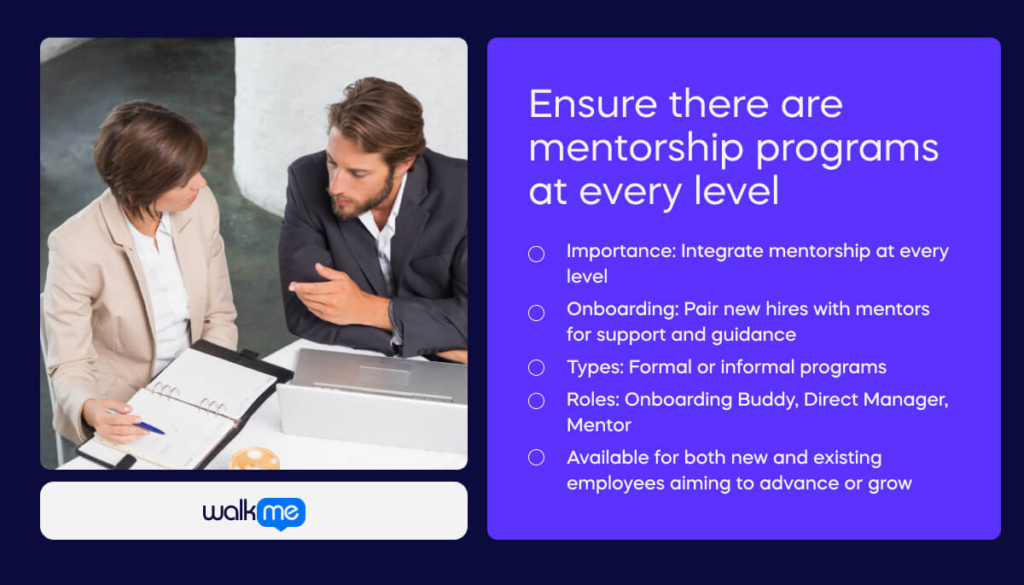
Using a mentor program within your onboarding process helps employees learn more about the organization. It also provides a go-to person for support and guidance. These programs allow employees to build relationships with those who can offer career advice and guidance.
Companies can establish formal or informal mentorship programs. When employees join the company, pair them with an onboarding buddy. This provides the new hire with another resource. This will be done in addition to their direct manager, who will answer questions or address concerns.
While a direct manager may focus on the employee’s current role, mentors can offer broader, long-term guidance related to professional development. Mentor programs aren’t limited to new employees. Existing employees may also seek a mentor when aiming to advance, transition to a new department, or grow within their role.
Having a mentor in a higher position helps employees understand how to achieve their career goals.
Adopt a flexible work arrangements policy
Allowing employees to work flexible hours can make them feel valued and considered. This flexibility accommodates childcare needs or midday hospital appointments. It also gives them more control over their time, even if they work the same number of hours.
Various work arrangements can significantly increase employee satisfaction without compromising performance. These include remote work, hybrid work, part-time positions, job-sharing, and compressed workweeks.
In many organizations, collaboration is crucial. Establishing core days employees must be in the office can be one approach. Alternatively, letting employees decide when to work from home can also be effective.
However, it is important to ensure that these arrangements don’t undermine the organization’s collaborative values. They should also help employees maintain a better work-life balance.
Prioritise transforming employees into leaders
Employees spend a significant amount of their time at work interacting with management. They will likely leave the company if they have a negative experience or feel they’re not receiving effective guidance.
Focus on training management in leadership, communication, and teamwork skills. Acknowledge and thank your direct reports who go the extra mile. Explain how their hard work contributes to the organization.
You can also create compelling recognition programs even with a small team or limited budget.
Don’t overlook succession planning. It can be an effective method for professional development and building leadership skills.
Allow employees to have a work/life balance
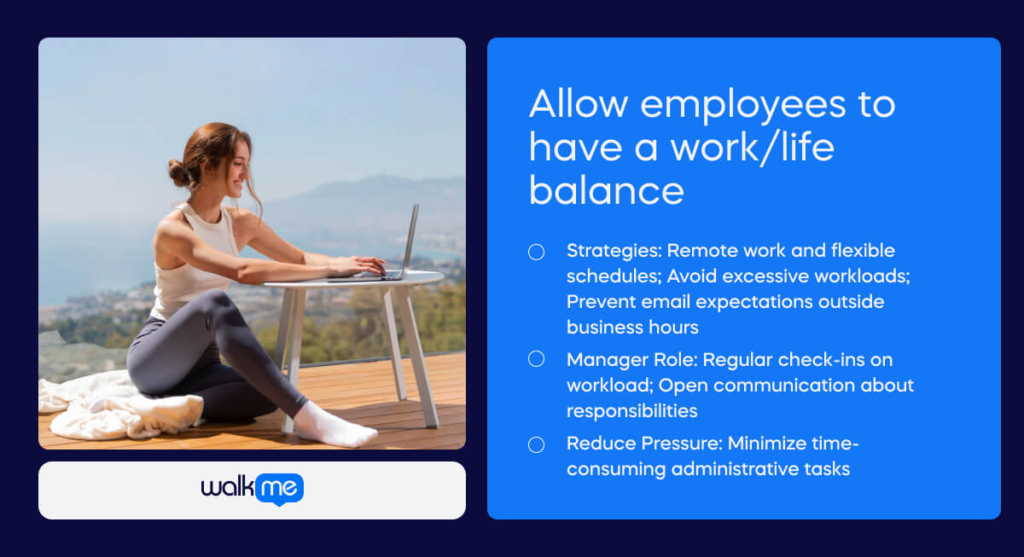
Work-life balance goes beyond just being a buzzword. Remote work and flexible scheduling policies can contribute to creating a work-life balance. But they’re ineffective if employees are overwhelmed with excessive work. This is also the case if the company culture expects them to check email outside of business hours.
Managers should often check in with employees to ensure they can manage their workload. They can also foster open communication about work responsibilities. Additionally, organizations can reduce workload pressures by reducing time-consuming administrative tasks.
Build a resilient, agile culture
Culture defines the experience of working at your company. Do employees feel supported, empowered, and engaged? Do they see the impact of their efforts and understand their work’s greater purpose? A meaningful culture involves rewarding employees not just for success but also for effort.
It includes creating a meaningful mission for your company. You can also involve employees in creative organizational decision-making. Building an agile workforce means expecting employees to thrive regardless of uncertainty. Failure is acceptable as long as employees learn lessons.
Reward effort, not just results. Ensure new hires integrate well with an agile team quickly, enhancing comfort and restoring productivity. Additionally, focus on hiring with diversity and innovation in mind.
If everyone in your organization shares the same background, thinking outside the box can be challenging. Aim for diversity in your hires to assemble a team with varied viewpoints and experiences.
Give employees beneficial perks and rewards as part of their employment package
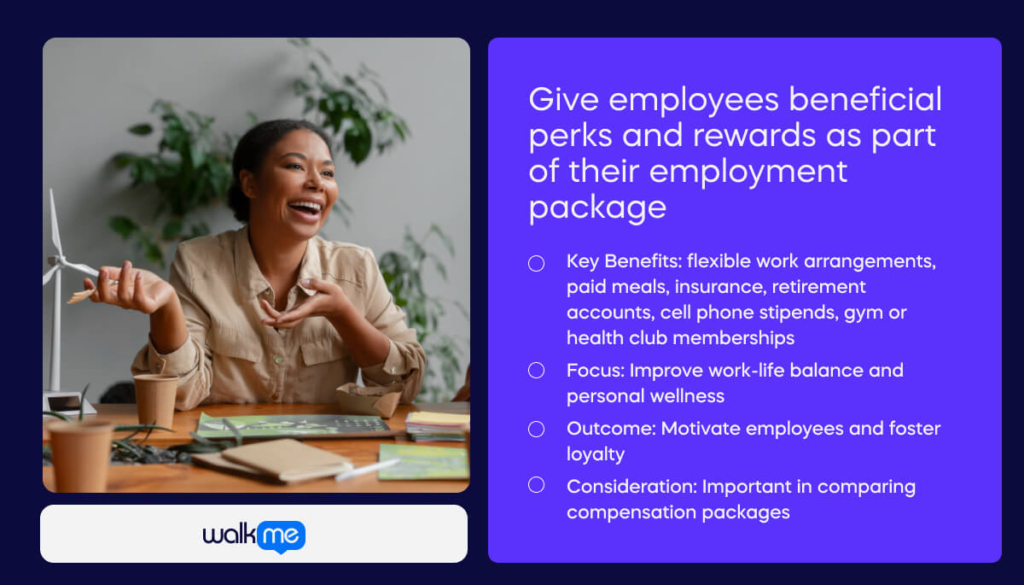
Benefits and perks can also enhance the competitiveness of a compensation package. Many modern employee benefits focus on improving work-life balance and personal wellness. These benefits can motivate employees and foster loyalty to your organization.
Employees appreciate benefits like flexible work arrangements, paid meals, insurance, and retirement accounts. They also like cell phone stipends and memberships to gyms or health clubs. They often consider these when comparing compensation packages from potential employers.
Build clear learning and development paths for employees
Employees who seek extra learning opportunities are curious people. Curious people make better employees. They’re the ones most likely to embrace challenges and come up with creative solutions.
If they lack stimulation, they’ll seek out opportunities to satisfy their curiosity elsewhere.
Your company can provide internal training opportunities to upskill your existing workforce. This requires an effective learning and development program. You can’t hastily assemble a program and expect to solve the problem overnight.
The issue isn’t the lack of professional development opportunities. It’s the lack of well-designed ones.
Understand how your employees prefer to learn. Consider whether employees prefer to learn at work or their own pace.
Such insights can help you make critical decisions. This includes choosing the right e-learning tool and determining the frequency of workshops.
Another option is to offer tuition help. You can support your employees by subsidizing their education. This tuition can be limited to specific courses valuable to your organization.
Source regular employee feedback
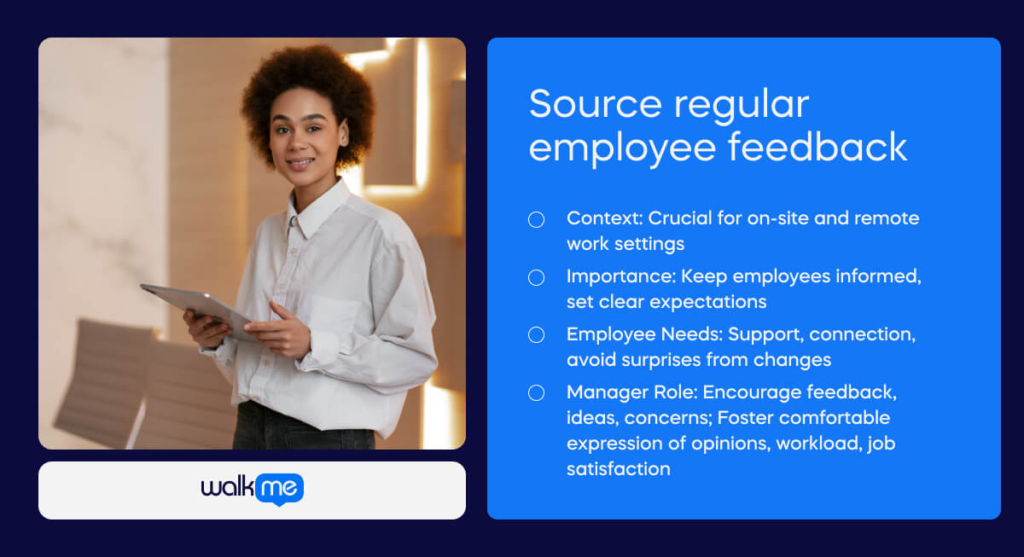
An organization needs to communicate authentically, honestly, and transparently with its employees. This applies whether they work on-site or remotely. Clear communication is crucial for informing employees about organizational happenings and setting expectations. This becomes especially important during turbulent business or economic periods.
Employees want to feel supported and connected. They also want to avoid being caught off-guard by organizational changes.
Managers should actively encourage employees to share their feedback, ideas, and concerns. Employees should feel comfortable expressing their opinions. They should also feel free to discuss their workload and job satisfaction.
Monitor employee turnover and retention
Employee retention is a continuous effort.
You need to maintain regular communication with your employees. This ensures their expectations are met and they remain satisfied with your organization.
This becomes particularly important during times of change.
To achieve this, use a tool to automatically survey your employees regularly. This tool can capture trends and alert you in real-time when a segment of employees shows an increased risk of turnover.
You can also analyze data from recently departed employees. This helps identify the real reasons behind turnover. This information empowers you to take early action and look at the issues before they worsen.
Recognize employee successes and milestones
Fair compensation is essential. However, employees also need recognition for their work and achievements. Feeling acknowledged by management can inspire them to work harder and stay loyal to the company.
When you notice an employee doing commendable work, speak up and acknowledge them. Sharing such recognition during meetings or through emails broadens the appreciation.
Having a plan to celebrate birthdays, work anniversaries, and other milestones can boost morale and motivate employees to remain committed to their roles.
Promote diversity, equity, and inclusion
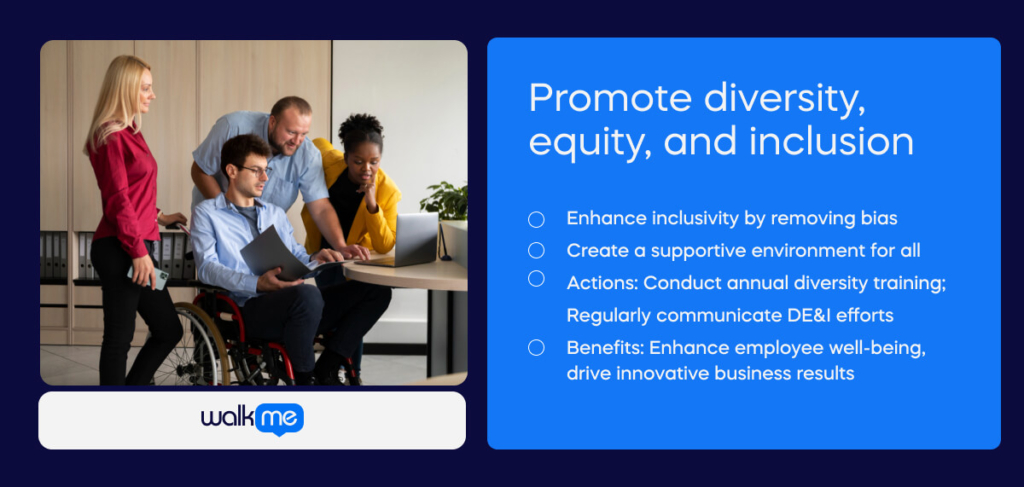
Diversity, equity, and inclusion are now expected in the workplace. Leaders should constantly think of ways to enhance inclusivity by removing bias and barriers to diversity. They need to create a work environment that supports everyone’s unique needs.This could involve rolling out diversity training at least once a year.
Regularly communicating about DE&I with each employee helps you identify areas where your efforts may fall short. Promoting inclusion improves employee well-being and brings innovative business results to the forefront.
When employees feel seen and included, they are more motivated to stay.
Plan properly for change management to avoid resistance
Every workplace faces both positive and negative changes. During these periods, employees often turn to leadership for guidance and reassurance.
If your organization is undergoing significant shifts, keeping your team well-informed can reduce anxieties. When making major announcements, consider communicating individually or in group calls or meetings.
Allow time for questions to address any concerns that arise. Use change management models, such as Maurer’s 3 Levels of Change and Resistance or McKinsey’s 7-S Framework. These can help minimize employee resistance and support successful business transformation.
Emphasize teamwork
Emphasizing teamwork is another essential aspect of employee retention in certain environments. Providing opportunities for collaboration, including cross-functional collaboration, can enhance teamwork and boost employee engagement.
Strong teamwork fosters bonding among coworkers. This contributes to a better organizational culture and leads to improved overall performance.
Effective teamwork enables managers and employees to identify strengths and weaknesses within departments. This allows them to balance the workload more strategically.
Reasons for employees leaving and staying
Employees leave organizations for various reasons. Some find new jobs, while others return to school. Some follow spouses who have relocated. Retirement and impulsive quits due to work-related or personal issues contribute to voluntary turnover. Additionally, some employees experience involuntary turnover through firings or layoffs.
Employees stay when the pay, working conditions, and developmental opportunities meet or exceed their expectations. These decisions are influenced by an individual’s desire to leave and the ease of departure.
There are four primary paths to turnover. Employee dissatisfaction is the first reason. To prevent this from happening, track workplace attitudes and address turnover drivers. Providing competitive rewards, developmental opportunities, and a quality work environment can help retain employees who are considering better alternatives.
Some employees leave due to planned life changes like family expansion or job advancements. Enhancing rewards tied to tenure or addressing employee needs can alter their plans. Negative experiences, like conflicts with supervisors, can lead to impulsive departures. Analyzing common work-related issues, such as harassment, can reduce this occurrence.
Other predictors of turnover include organizational commitment, job satisfaction, and the quality of employee-supervisor relationships. It could also include the lack of role clarity, job design, and workgroup cohesion.
Understanding why valuable employees stay is as crucial as knowing why they leave. Employees become embedded in their jobs and communities. They develop a network of connections both professionally and personally. The more embedded employees are, the more likely they are to stay.
Companies can foster employee engagement through various initiatives. These include mentorship programs, team-based projects, and team cohesion efforts. Clear communication about company values and culture also contributes to retention.
Employees who receive regular recognition for their work are more likely to stay longer with organizations. Opportunities for internal mobility, such as transfers, also contribute to employee retention. Competitive employee benefits and pay further reduce the likelihood of employees leaving.
What’s next for employee retention strategies?
The best way to improve employee retention is to prevent them from leaving. It may sound simple, but it’s true. Employees who are happy with their work, colleagues, and compensation tend to stay in their jobs for longer.
Don’t wait until an employee is on the verge of leaving to discuss retention strategies. This approach can seem insincere and is often ineffective. Deciding to leave a job doesn’t happen overnight. Once someone secures another position, convincing them to stay becomes difficult.
Attrition can also spread within a team. To mitigate this, ensure departing employees leave on good terms. Recognize their contributions and inquire about their experience working with you. Exit interviews can provide valuable feedback to help reduce employee turnover.
Offer opportunities throughout the year to discuss openly the employee experience. You can host meetings, open forums, or send out anonymous surveys. Retention is an ongoing process influenced by daily interactions.
There’s no definitive list to ensure team members stay; you must engage with them and communicate regularly. They are your best source of insight into company culture and their motivation to continue working for you.
But it doesn’t stop there. Retention requires continuous attention. Being proactive about it is the most effective approach.
Investing time and effort into keeping your employees satisfied is worthwhile. Effective employee retention strategies are essential for maintaining a productive, profitable company.

